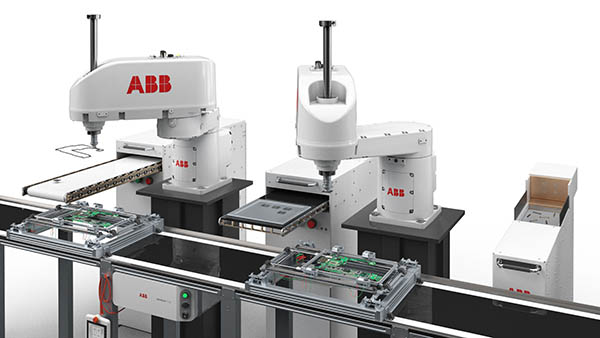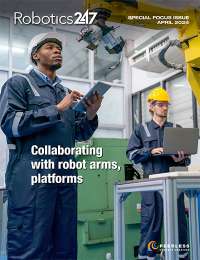The presence of robots in the electronics industry is not new. What is new, however, is the rate at which manufacturers in this sector are deploying robotics and the applications in which they are using the technology.
“We’re seeing accelerated adoption by manufacturers thanks to increased demand for semiconductor products, rising labor costs, and innovations that allow robotics to address new problems,” said Adrian Choy, product manager-robotics at Omron Adept Technologies.
Innovations open the door to new applications
The recent improvements have helped robots to adapt to the changing manufacturing environments.
“As the automation community has evolved, robots have become a key technology that designers rely on because of their flexibility,” said Brian Rockwell, North American key account manager at Festo. “The robotic industry continues to push norms and standards by solving difficult safety hurdles and improving software tools, making integration of robotics more accessible to a broader pool of candidates.”
As a result of these innovations, achievable performance now provides unprecedented levels of efficiency.
“Robots are able to perform these jobs with higher accuracy, repeatability, and speed than human operators,” said Choy. “This guarantees higher quality, lower scrap rates, increased part-per-minute production, and reduced risk of costly product recalls.”
Robots take production to the next level
These robotics advances now allow European and U.S. manufacturers to be competitive in the global economy of electronics manufacturing.
“The demand for increased throughput and quality, coupled with current labor constraints, positions automation to be used to help manufacturers overcome these obstacles to take their production to the next level,” said Joshua Alphonse, local business line manager, electronics U.S., at ABB Robotics. “The use of robotic automation across the spectrum of electronics manufacturing, however, varies based on the applications at hand.”
On the far upstream side of electronics manufacturing, robotic automation in semiconductor manufacturing ranges from edge grinding, surface polishing, and cleaning to loading finished chips for testing, final packaging, and palletizing.
Midstream electronics manufacturing encompasses electronic components manufacturing and assembly onto printed circuit boards. Here, robots are used to handle the placing of components onto circuit boards prior to soldering.
“Circuit-board handling using collaborative robots for transporting between stations, as well as to automate circuit testing, is a key area for automation in this space,” added Alphonse.
The downstream use of robotics in electronics manufacturing focuses on the assembly of final goods, such as consumer electronics. Robotic automation at this stage is focused on material handling, screw driving, vision inspection, and micro dispensing of adhesives or thermal paste.
Select the right robot for the application
There are several distinct types of industrial robots used in electronics manufacturing, each with their own strengths and weaknesses that must be evaluated within the context of an application.
Three of the key types of robots at play in these applications include the six-axis robot arm, SCARA, and delta robots. It’s important to understand how each robot type fits into the automation systems of these industrial sectors.
For example, a six-axis robot offers excellent overall range of motion and capability. Many moves required in automation are not in a straight line, so a six-axis robot provides a great deal of capability. Furthermore, the size ranges of six-axis robots are expansive, which allows users to leverage this type of robot for a variety of processes.
A six-axis robot is a good fit for dispensing glue, potting, and liquid gaskets, as well as performing soldering, material transfer, final packaging, and palletizing applications. On the downside, these are the most expensive of the three types of robots.
On the other hand, the four-axis arm SCARA robot, however, has a more restrictive range of motion than the six-axis robot. The SCARA excels at high-speed material transfer. Typically designed for lighter payloads, this type of robot provides a compact footprint and has highly accurate positioning capabilities.
A typical application for a SCARA robot is small-component assembly. SCARA robots can also perform material transfer very quickly, accurately, and cost effectively.
The third type is the delta robot, which mounts above the work envelope. From the base, three arms extend inward connecting to a common tooling plate used to mount working tools. The actuation works with a limited range of motion in an X/Y/Z direction.
Delta robots are suitable for small, lightweight part handling and processes. This type of robot is extremely fast and accurate, and it is ideal for clean environments. If the application requires extremely fast part handling or manipulation of lightweight parts, or a small working envelope, the delta is a good option to consider.
Make way for robot upstarts
“The next phase of robotic evolution is in human-machine collaboration, and the introduction of the collaborative robot (cobot) is a major innovation in automation,” said Rockwell.
Cobots allow workspaces to be more flexible, enabling humans and robots to work in tandem. Autonomous mobile robots (AMRs) also offer the benefit of working alongside human operators while automating low value-add processes like material handling. Both types of robots are designed with ease-of-use and simplified integration in mind.
“We are seeing cobots and AMRs make the industry rethink how we utilize robots,” said Choy.
Cobots take on inspection tasks
An example of robots’ ability to enhance electronics manufacturing can be seen in Koyo Electronics Industries response to a surge in demand for its in-car touch panels.
To address this issue, the electronics company chose Universal Robots UR3 cobot to be used in touch-panel production. The UR3 provides adjustable force capabilities required by touchscreen inspections, enables safe human-robot collaboration without safety fencing, and offers a space-saving footprint that precludes significant changes to existing production lines.
When the UR3 touches the touch panel with a stylus and no errors are found, an “OK” message is displayed, and the green signal tower light is activated. If an abnormality is detected, an “NG” is displayed and the red signal tower is activated along with a continuous buzzer sound.
The UR3 deployment increased productivity at Koyo by 31percent and halved the number of people required to handle touch panel inspection tasks. Furthermore, the company realized ROI in 12 months.
“Not only has our company been able to improve productivity by allocating resources to another production process but implementing this robot has built confidence and high hopes for future development,” said Katsuhiko Nakatani, deputy general manager of the production department at Koyo Electronics Industries.
Robotics help trigger global changes
An important point brought up by Koyo’s deployment of robots in its touch panel production process is the change that robotic automation promises to bring to the balance of forces in the electronics industry.
“The demand in electronics will continue to increase, and robots will continue to be an important factor, especially as labor costs increase in regions of the world where labor has been historically too low to justify robotic automation,” said Jerry Perez, executive director of global accounts at FANUC America. “With labor shortages that are seen globally, the demand for onshoring manufacturing to reduce the risk of supply chain delays is growing, and robotic automation usage is increasing at a historically high rate.”
About the Author
Follow Robotics 24/7 on Linkedin
Article topics
Email Sign Up






















